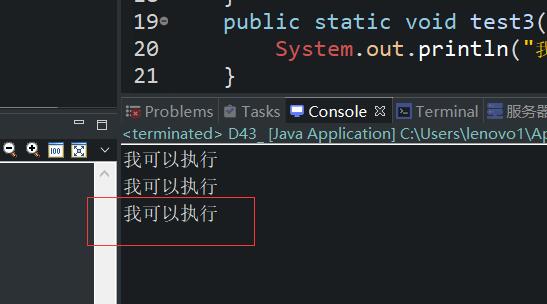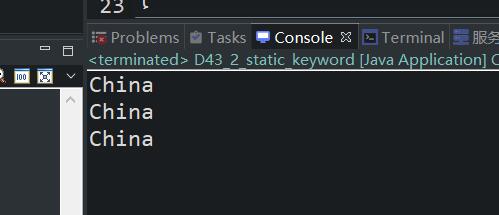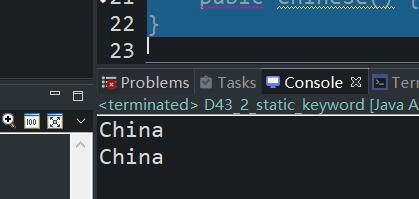一、其他注意点
1.对于带有static的方法,我们讲过需要用“类名.”的方式进行访问,但是其实我们使用“引用.”的方式也是可以进行访问这个方法的举例。
package com.bjpowernode.java_learning; public class D43_ { public static void main(String[] args) { Test3.test3(); Test3 t1 = new Test3(); t1.test3(); } } class Test3{ String name; public Test3() {} public static void test3(){ System.out.println("我可以执行"); } }

2.对于上面的特性,为什么这样,我想用下面这个更进一步的例子,也许可以知晓一二了,我们之前讲过空指针异常。
这个空指针异常,是指空引用访问实例相关的数据就是对象相关的数据,这些数据在访问的时候,必须有对象的参与,当空引用的时候,对象是不存在的,访问这些数据就会出现空指针异常。
我们在紧接着上面的程序,再加一段执行程序
t1 = null; t1.test3();

我们可以看到,即使是空指针,也照样可以执行并没有出现空指针异常,这说明了这里的t1这个对象,我们根本就没用到它,在执行的时候,系统依然会改写为Test3.test3()这样进行执行。
但是这种方式不推荐,虽能执行但不合我们的逻辑。
二、静态变量
1.首先看一段对象创建的代码
package com.bjpowernode.java_learning; public class D43_2_static_keyword { public static void main(String[] args) { Chinese c1 = new Chinese("zhangsan",32,"China"); Chinese c1 = new Chinese("lisi",34,"China"); } } class Chinese{ String name; int id; String country; public Chinese(String name,int id,String country) { this.name = name; this.id = id; this.country = country; } }
解释:我们创建了两个Chinese对象,他们的国籍都是中国,但是这样我们每次创建都得写一次China,这样就造成了代码的冗余,当我们去掉这个实例变量的时候,场景不合理,还需要这样的属性值,因此我们对于这种对象都共有的属性,引出静态变量的概念。
2.静态变量,也就是在类的代码中,对于实例变量,我们加一个static关键字,代表这个属性是所有创建出来的该对象共有的属性
(1)静态变量在类加载的时候进行初始化,不需要创建对象了,内存就开辟出来了。
(2)静态变量存储在方法区内存。
例子:
package com.bjpowernode.java_learning; public class D43_2_static_keyword { public static void main(String[] args) { Chinese c1 = new Chinese("zhangsan",32); System.out.println(c1.country); System.out.println(Chinese.country); c1 = null; System.out.println(c1.country); } } class Chinese{ String name; int id; static String country = "China"; public Chinese(String name,int id) { this.name = name; this.id = id; } pubic Chinese() {} }

个例子可以看出我们访问这个实例变量的时候,可以用"类."访问,也可以用"引用."访问,都成功了,而且原理也和我们上面讲述空指针类似,下面的再几个例子。
package com.bjpowernode.java_learning; public class D43_2_static_keyword { public static void main(String[] args) { // Chinese c1 = new Chinese("zhangsan",32);//这样写报错因为,缺一个参数,即使是提前被定义了 Chinese c2 = new Chinese("lisi",34,"fhai"); //换个值 Chinese c3 = new Chinese("lisi",34,"China"); System.out.println(c2.country); System.out.println(c3.country); } } class Chinese{ String name; int id; static String country = "China"; public Chinese(String name,int id,String country) { this.name = name; this.id = id; this.country = country; } pubic Chinese() {} }

解释:说明即使我们定义了构造函数来修改这种对象里面的country值也修改不了。
(3)总结:
i.static英语的那次翻译为:静态的;
ii.static修饰的方法是静态方法;
iii.static修饰的变量是静态的;
iv.所有的static修饰的元素都称为静态的,都可以使用“类名.”的方式进行访问,当然也可以用“引用.”的方式进行访问(但不建议这么做)
三、源码:
D43_other_anouncements_of_interviewing_object.java
D43_2_static_keyword1.java
D43_2_static_keyword2.java
地址:
https://github.com/ruigege66/Java/blob/master/D43_other_anouncements_of_interviewing_object.java
https://github.com/ruigege66/Java/blob/master/D43_2_static_keyword1.java
https://github.com/ruigege66/Java/blob/master/D43_2_static_keyword2.java
2.CSDN:https://blog.csdn.net/weixin_44630050(心悦君兮君不知-睿)
3.博客园:https://www.cnblogs.com/ruigege0000/
4.欢迎关注微信公众号:傅里叶变换,个人公众号,仅用于学习交流,后台回复”礼包“,获取大数据学习资料




 浙公网安备 33010602011771号
浙公网安备 33010602011771号